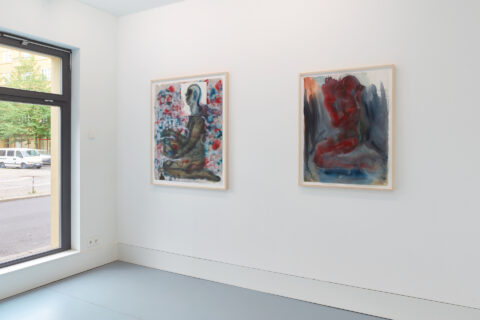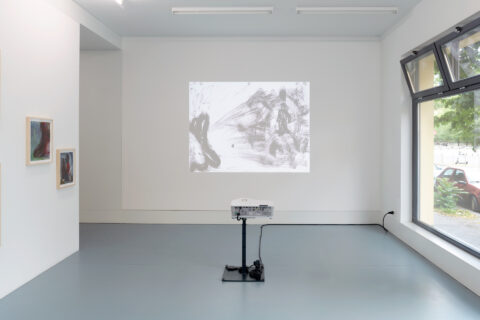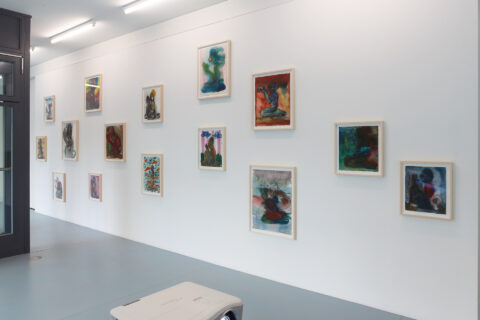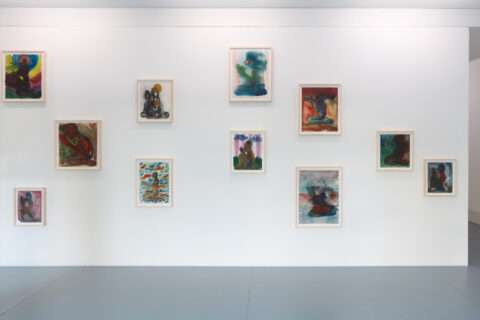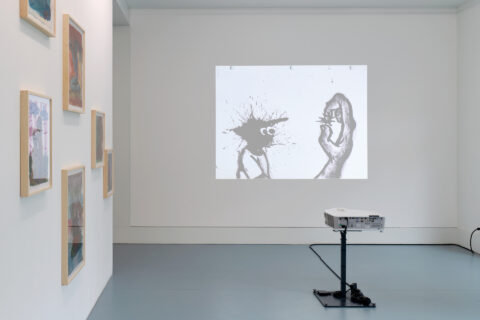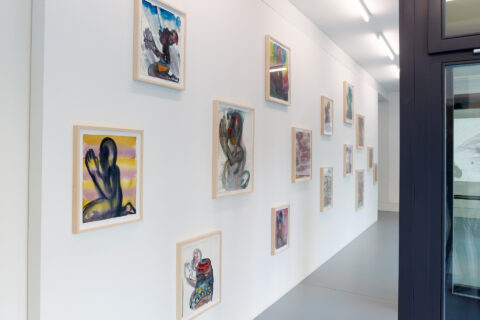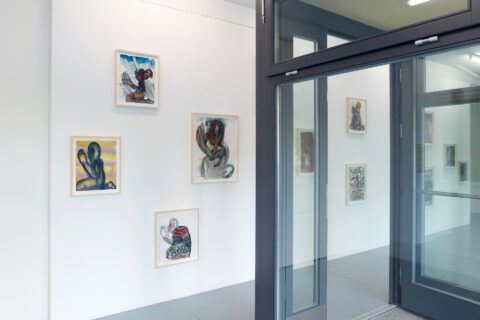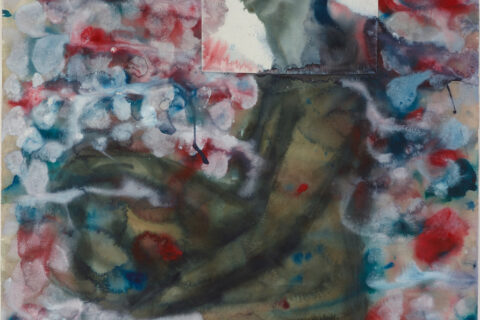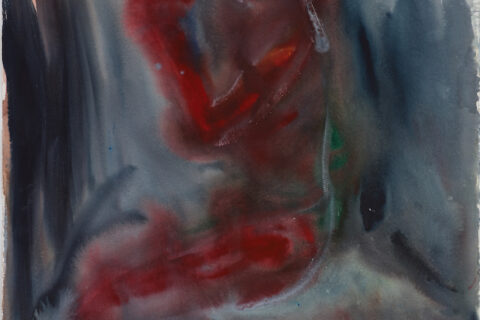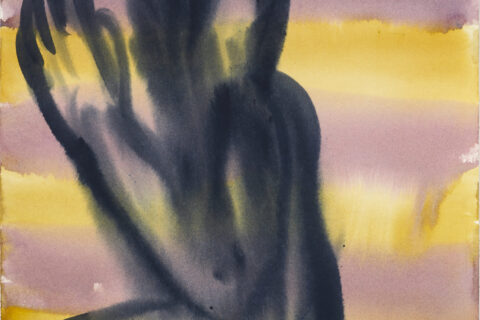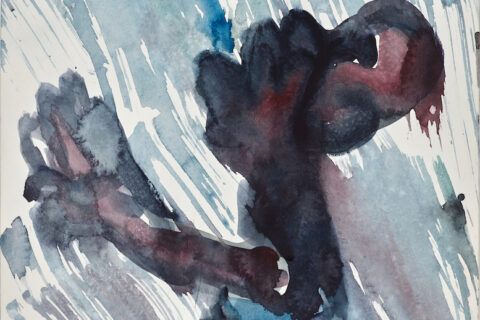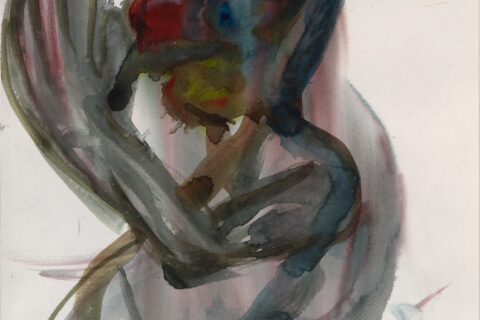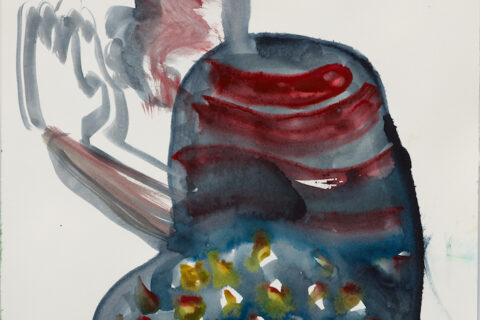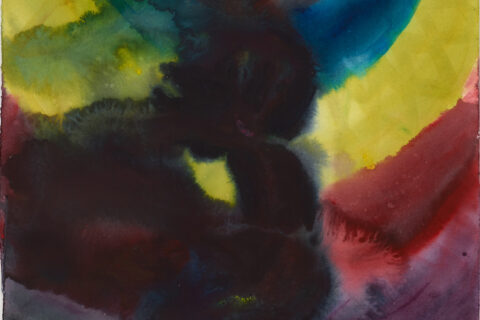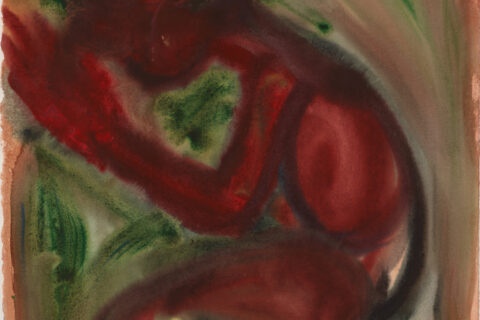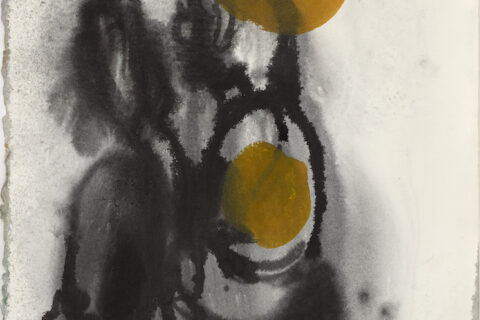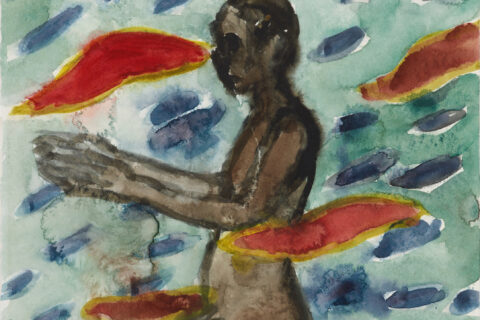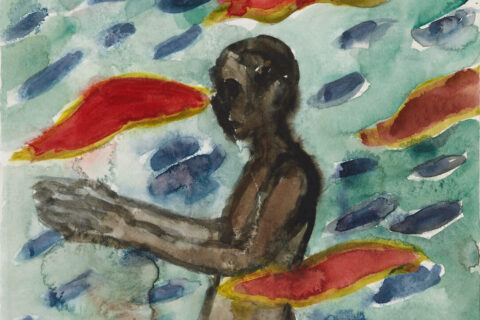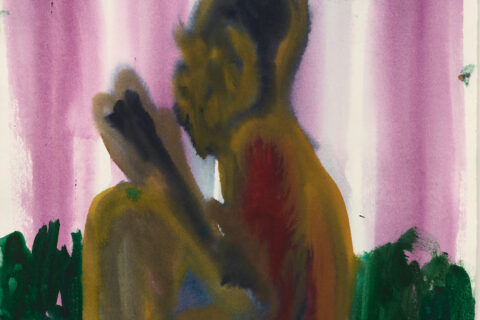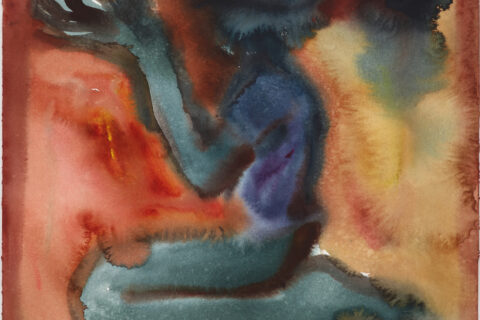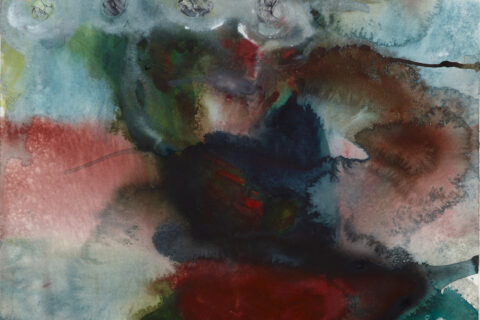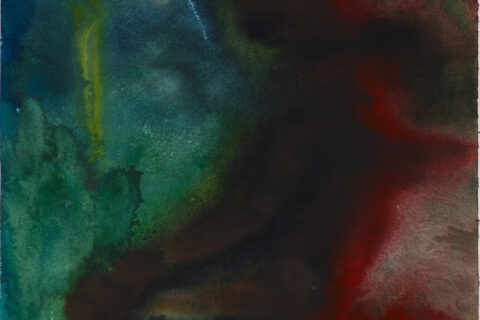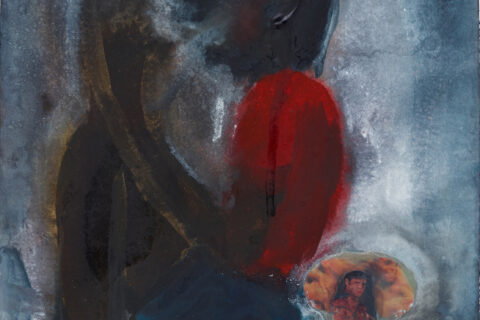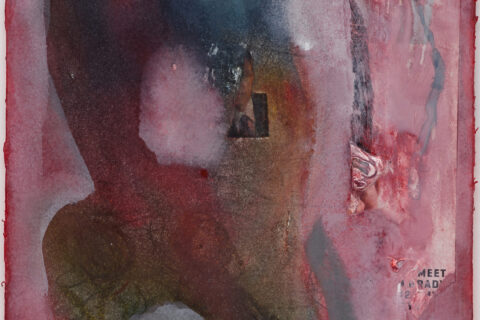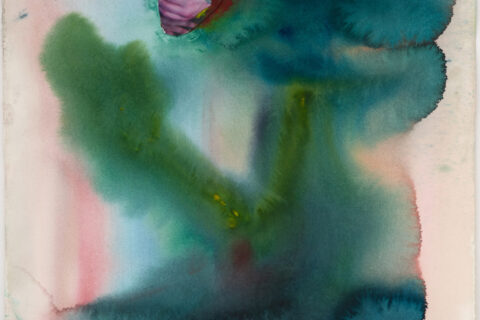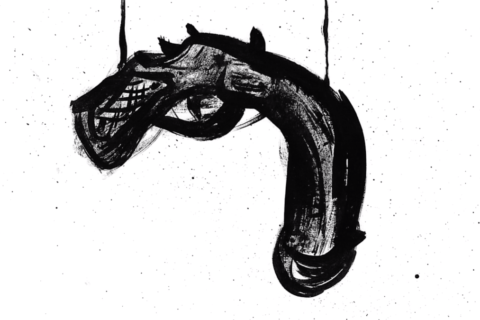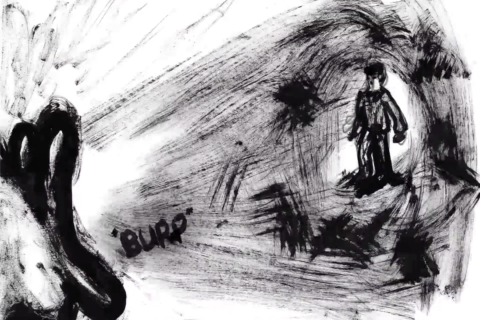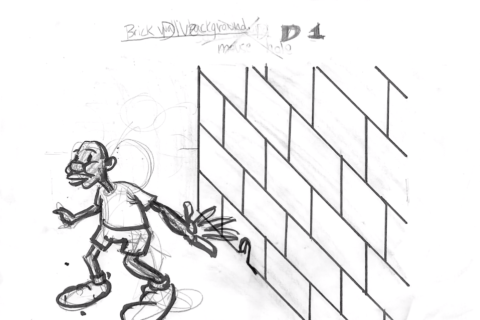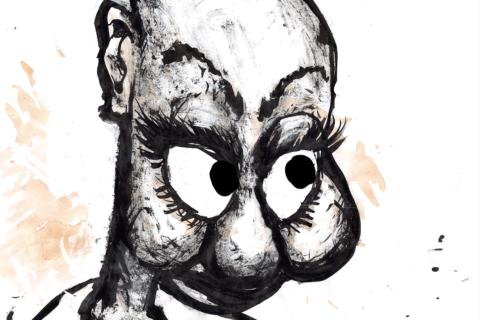Elliott Jamal Robbins The Immaterial and the Flesh
12/09/2020 – 01/11/2020
Nagel Draxler Kabinett
Rosa-Luxemburg-Str. 33
10178 Berlin
Eröffnung: Freitag, 11. Sept., 12–21 Uhr
Opening: Friday, Sept. 11th, 12–9 pm
Öffnungszeiten / Hours:
Dienstag bis Samstag, 11-18 Uhr (ausgenommen sind Feiertage)
Tuesday to Saturday, 11am-6pm (excluding public holidays)
und nach Vereinbarung / and by appointment: berlin@nagel-draxler.de
Verlängerte Öffnungszeiten / extended opening hours:
Samstag, 12. Sept. & Sonntag, 13. Sept.: 12–19 Uhr
Saturday, Sept. 12th & Sunday, Sept. 13th: 12–7 pm
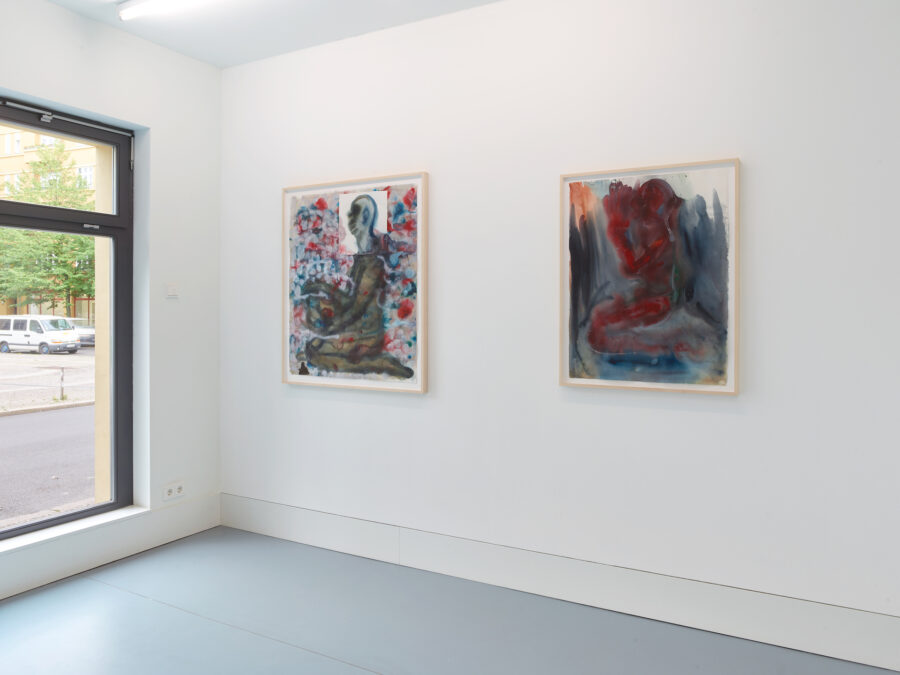
Elliott Jamal Robbins
„The Immaterial and the Flesh“
Installation view
Nagel Draxler Kabinett, Berlin 2020
Photo: Simon Vogel
„The Immaterial and the Flesh“
Installation view
Nagel Draxler Kabinett, Berlin 2020
Photo: Simon Vogel
„The Immaterial and the Flesh“
Installation view
Nagel Draxler Kabinett, Berlin 2020
Photo: Simon Vogel
„The Immaterial and the Flesh“
Installation view
Nagel Draxler Kabinett, Berlin 2020
Photo: Simon Vogel
„The Immaterial and the Flesh“
Installation view
Nagel Draxler Kabinett, Berlin 2020
Photo: Simon Vogel
„The Immaterial and the Flesh“
Installation view
Nagel Draxler Kabinett, Berlin 2020
Photo: Simon Vogel
„The Immaterial and the Flesh“
Installation view
Nagel Draxler Kabinett, Berlin 2020
Photo: Simon Vogel
Watercolor and Carpet on paper
105.41 x 88.90 cm
Photo: Simon Vogel.
Watercolor on paper
91.44 x 69.85 cm
Photo: Simon Vogel.
Watercolor on paper
40.64 x 33.02cm
Photo: Simon Vogel.
Watercolor on Paper
40.64 x 31.75 cm
Photo: Simon Vogel.
Watercolor on paper
60,33 x 45,72 cm
Photo: Simon Vogel.
Watercolor on paper
43,18 x 36,83 cm
Photo: Simon Vogel.
Watercolor on Paper
49.5 x 40.64 cm
Photo: Simon Vogel.
Watercolor on paper
49,53 x 43,18 cm
Photo: Simon Vogel.
Watercolor on paper
40,64 x 33,02 cm
Photo: Simon Vogel.
Watercolor on paper
46,99 x 33,66 cm
Photo: Simon Vogel.
Watercolor on paper
40,64 x 33,02 cm
Photo: Simon Vogel.
Watercolor on paper
49,53 x 40,64 cm
Photo: Simon Vogel.
Watercolor and Collage on paper
60,96 x 45,72 cm
Photo: Simon Vogel.
Watercolor on paper
36,83 x 33,02 cm
Photo: Simon Vogel.
Mixed Media on paper
34,29 x 27,94 cm
Photo: Simon Vogel.
Mixed Media on paper
35,56 x 26,67 cm
Photo: Simon Vogel.
Watercolor and Collage on paper
53,34 x 40,64 cm
Photo: Simon Vogel.
Digital film
23 seconds (loop)
Digital film
23 seconds (loop)
Digital film
4 seconds (loop)
Digital film
47 seconds (loop)
Press Release
Modern religions are built upon the principle that there are two realms in which all humans concurrently occupy. The flesh, and the immaterial. The flesh refers to that which is experiential, physical, sexual, and flawed by its enslavement of the senses, and therefore illusory. Conversely, the Immaterial is associated with the spiritual, non-corporal, transcendental, and intellectual. The exhibition, The Immaterial and the Flesh, is situated in the space in-between this binary, which positions what is corporal and physically experienced in opposition to the imaginary and invisible; between the real and the unreal. As well, the notion of conflict between the body and what is unseeable, can be felt at every level of the current political climate globally. As headlines around the world reveal social and racial inequities which are heightened by the myriad ecological disasters happening all the time, the coronavirus pandemic provides a backdrop for Robbins’ to consider the implications of the contemporary moment on the body. Through the repetition of a single form, the kneeling figure, the viewer is shown a tapestry of images that seamlessly weave together social criticism, personal narrative, desire, and wish fulfillment.
Robbin’s “Votive Figures”, are a group of watercolor paintings showing a figure depicted in a kneeling position. The title of these works is a nod to a practice that can be seen in various cultures, in which a small statue or painting would be commissioned and placed in an altar, either for a god(s) or saint, such as early Sumerian votive statues, or the tradition of Ex-voto painting found in Mexico. The figure also has a formal association with protests by athletes in the United States, that would take a knee during the National Anthem, which would be played before a game. As well, it is a reminder of the recent death of George Floyd, in which a police officer knelt on his neck for 8 minutes and 46 seconds, killing Floyd and sparking what has been an ongoing period of protest around the world against police brutality, and the abuses of state power. Robbins’ Votive Figures aren’t prayer objects in the same way that the Sumerian figurines or the Ex-votos are. Nor do they exactly function as protest images. Rather, the figure in this position becomes a substrate for Robbins to meditate on the intersectional spaces inhabited by this body. These works are simultaneously diaristic, referential of various histories of painting, as well as a loaded reminder of the current political and social climate. The inclusion of a text-based work expands the discourses surrounding representation. Here a viewer is presented with a narrative from the position of someone who must navigate the loss of a loved one while encountering a system that is hostile towards them, recalling the image of someone who has been brought to their knees by forces outside of their control. The animated filmic works of Robbins in this context further demonstrate how representation is performed, where the type, stereotype, symbol, and signifier collide with one another, are conflated, and negate each other via the projected moving picture plane.
The Immaterial and the Flesh marks the first solo exhibition with Elliott Jamal Robbins at Nagel Draxler Kabinett, and the first solo exhibition for the artist outside of the United States of America. Robbins, born 1988 in Oklahoma City, lives and works in Tucson, Arizona.
_____________________
Moderne Religionen bauen auf dem Prinzip auf, dass es zwei Bereiche gibt, die alle Menschen gleichermaßen definieren. Das Immaterielle / Geistige und das Körperliche / Fleischliche. Das „Fleischliche“ bezieht sich auf das, was erfahrungsmäßig körperlich und sexuell ist und durch Unterwerfung unter Instinkte die Wahrnehmung fehleranfällig und illusionär macht. Umgekehrt wird das Immaterielle mit dem Geistigen, Nicht-Körperlichen, Transzendentalen und Intellektuellen assoziiert. Die Ausstellung The Immaterial and the Flesh ist im Raum zwischen den beiden Polen angesiedelt, sieht das Körperliche und das physisch Erlebte im Angesicht des Imaginären und Unsichtbaren, positioniert sich zwischen dem Realen und dem Irrealen.
Die alte Vorstellung eines Konflikts zwischen dem Körperlichen und dem Geistigen ist auf allen Ebenen des gegenwärtigen Weltgeschehens spürbar. Schlagzeilen über soziale und ethnische Ungerechtigkeiten, die durch unzählige Umweltkatastrophen verstärkt werden, treten durch die Coronavirus-Pandemie weiter in den Vordergrund. Dies bildet den Hintergrund für Robbins' Überlegungen zu den Auswirkungen der gegenwärtigen Lage auf das Verständnis des Körperlichen. Robbins "Votive Figures" sind Aquarelle, die eine kniend dargestellte Figur zeigen. Durch die Wiederholung der Form dieser knienden Figur, erzeugt der Künstler einen „Corpus“ von Bildern, die persönliche Erzählung, Wunsch und Wunscherfüllung sowie Kritik an sozialer Ungerechtigkeit miteinander verweben.
Der Titel "Votive Figures" ist eine Anspielung auf eine in verschiedenen Kulturen anzutreffende Praxis, bei der kleine Statuen oder Gemälde für Altare in Auftrag gegeben werden, entweder für einen Gott oder einen Heiligen, wie etwa frühe sumerische Votivstatuen oder die mexikanischen Tradition der Ex-Voto Malerei. Die kniende Figur hat einen formalen Bezug zu Protesten von SportlerInnen wie Colin Kaepernick in den Vereinigten Staaten, die während des Abspielens der Nationalhymne in die Knie gehen. Außerdem erinnert die kniende Figur an den Tod von George Floyd, verursacht durch einen Polizeibeamten, der 8 Minuten und 46 Sekunden lang auf seinem Nacken kniete. Ein Ereignis, welches Auslöser für eine anhaltende Welle des weltweiten Protests gegen die Brutalität der Polizei und den Missbrauch von Staatsgewalt war.
Robbins' Votivfiguren sind keine Gebetsobjekte, so wie es die sumerischen Figuren oder die Ex-Votos sind. Sie funktionieren auch nicht eindeutig als Protestbilder. Vielmehr dienen sie ihm als eine Art Substrat seiner Auseinandersetzung mit dem Körperlichen und dem Geistigen. Eine textbasierte Arbeit, die von den AusstellungsbesucherInnen mitgenommen werden kann, erweitert den Diskurs um Fragen der Repräsentation. Es handelt sich um eine poetische Erzählung aus der Position eines Menschen, der den Verlust eines geliebten Menschen betrauert, während er auf ein System trifft, das ihm feindlich gesinnt ist, und von Kräften außerhalb seiner Kontrolle in die Knie gezwungen wird. Die animierten filmischen Arbeiten von Robbins führen vor, wie Repräsentation stattfindet. In ihnen kollidieren Typus, Stereotyp, Symbol und Signifikant miteinander oder werden zusammengeführt, um sich über die projizierte, bewegte Bildebene gegenseitig zu negieren.
The Immaterial and the Flesh ist die erste Einzelausstellung mit Elliott Jamal Robbins bei Nagel Draxler und die erste Einzelausstellung des Künstlers außerhalb der Vereinigten Staaten von Amerika. Robbins, geboren 1988 in Oklahoma City, lebt und arbeitet in Tucson, Arizona.
